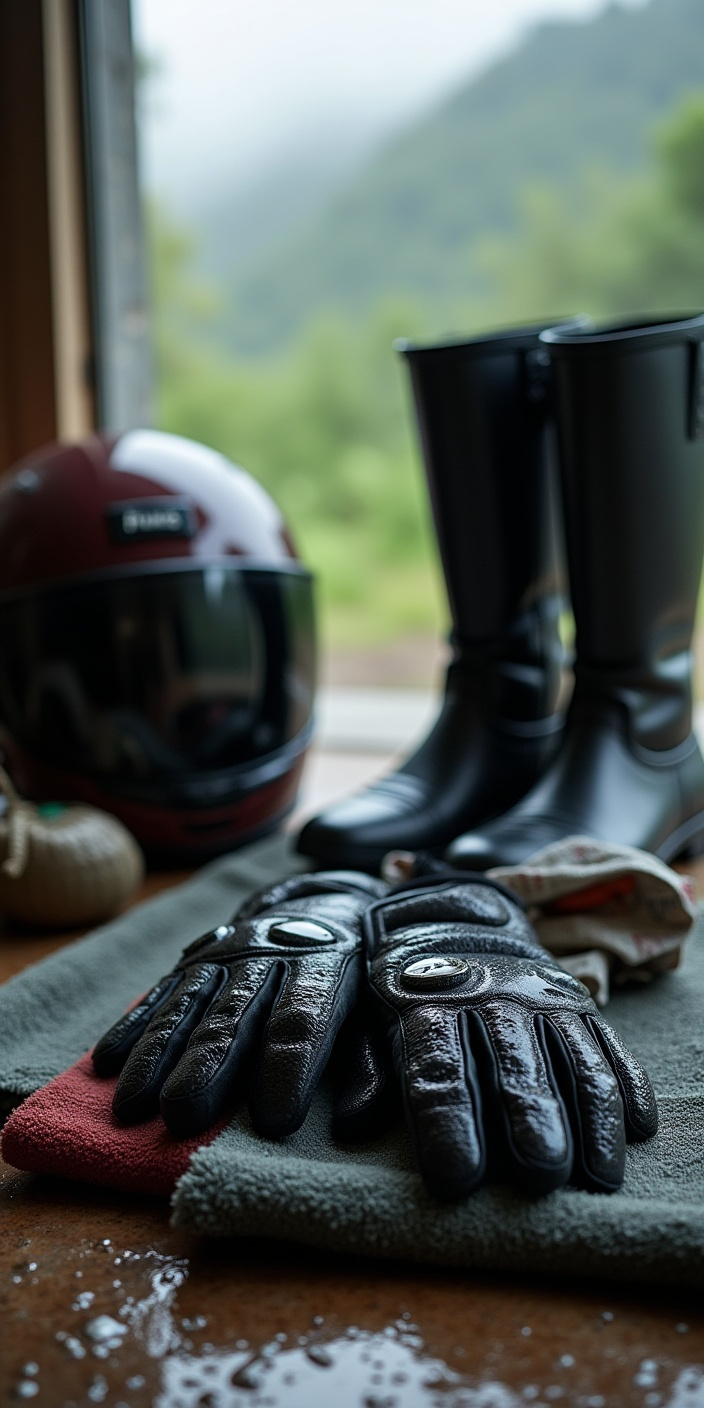For Indian motorcyclists, the monsoon brings lush landscapes and a fresh sense of adventure. However, it also brings wet, muddy gear and the constant struggle with damp, smelly riding gloves. Mastering your monsoon glove care routine is essential if you want your gloves to last, avoid odours, and maintain grip and protection on every ride.
In this guide, we’ll walk you through the correct way to clean and dry your gloves during rainy rides. You will also learn how to maintain riding gloves in the rainy season and discover anti-odour glove cleaning methods that work. For more insights, check out ReiseMoto’s monsoon riding checklist.
Why Does Your Monsoon Glove Care Routine Matters?
Riding with wet or unclean gloves is not only uncomfortable but also damaging. It weakens the glove’s structure, compromises protection, and creates a perfect environment for bacteria and mould to grow. Wet gloves also lose grip and flexibility on the throttle and brakes, two essentials for protective riding gloves in India. That is why a reliable glove care routine is a must for monsoon riders in India.
How to Clean Riding Gloves After a Rainy Ride?
Use this process to safely clean both textile and leather gloves without affecting their integrity.
1. Shake Off Excess Dirt and Water
Once you’re off the saddle, shake the gloves gently to flick off water and mud. Use a soft brush or cloth if needed to remove sticky debris.
2. Wash According to Material Type
Textile and Synthetic Gloves:
- Hand-wash gently in lukewarm water using mild detergent or baby shampoo. Avoid harsh soaps that can degrade waterproof coatings.
- If the gloves are machine-washable, use a delicate cycle and put them in a mesh laundry bag for extra protection.
Leather Gloves:
- Wipe with a damp cloth to remove surface grime.
- Use a leather cleaner or specialised glove cleaner sparingly and only when necessary.
- Never soak leather gloves fully. It strips the oils and makes the material stiff and fragile.
3. Rinse Without Wringing
Rinse off soap thoroughly, but avoid ringing or twisting the gloves. Doing so can damage stitching and internal padding.
Drying Wet Riding Gloves Quickly and Safely
A solid routine for drying wet riding gloves quickly requires airflow, care and patience.
- Blot Moisture
Press gloves between two dry towels to absorb as much moisture as possible. Do not wring or twist.
- Retain Shape
Put them on briefly while damp to keep the correct finger and palm form before you leave them to dry.
- Use a Newspaper or Towels
Stuff the gloves with newspaper or dry cotton cloth to soak up moisture from inside. Replace the stuffing every few hours.
- Promote Air Drying
Place gloves in an open, shaded area with good airflow. Avoid direct sunlight, hair dryers or any high heat source, as they can harden or shrink both synthetic and real leather.
- Boost Drying with a Fan
Use a table or pedestal fan for extra air circulation. Hanging the gloves by their cuffs will also improve drying efficiency.
Anti-Odour Glove Cleaning Methods
Gloves often begin to smell after repeated use in the rain. Prevent that with these rider-tested techniques:
-
Baking Soda:
Sprinkle inside gloves before drying. Let it sit for a few hours and shake it out before the next use.
-
White Vinegar Mix:
Wipe the inside lightly with a diluted vinegar solution (1 part vinegar to 3 parts water). This acts as a natural deodoriser.
-
Anti-bacterial Sports Gear Spray:
Use a glove-safe sanitising spray to stop odour-causing bacteria in its tracks.
-
Tea Bags or Charcoal Packs:
Slip one into each glove overnight to absorb moisture and remove unwanted smells.
Glove Maintenance Tips for the Rainy Season
Keeping your gloves in shape during the monsoon is not difficult if you follow these steps regularly:
-
Inspect Regularly:
After wet rides, check seams, Velcro, and padding for damage or wear.
-
Condition Leather:
Once dry, apply a quality leather conditioner to prevent cracking. Use minimal product and make sure the gloves are fully dry first.
-
Store Properly:
Never store wet gloves in sealed bags or top boxes. Instead, let them dry fully and store in a cool, ventilated place.
-
Carry a Spare Pair:
If touring regularly, having a second pair of waterproof gloves is a game-changer. Find options under ReiseMoto’s rain gear section.
-
Layer Smartly:
For riders using non-waterproof gloves, an inner latex or nitrile glove adds a layer of water resistance in emergencies.
Buying and Caring for the Right Gloves
ReiseMoto offers a wide range of monsoon-ready and protective riding gloves for Indian riders from top motorcycle brands. Some gloves combine breathable waterproof lining with CE-certified knuckle protection, ideal for Indian monsoons.
Other great options in ReiseMoto’s collection include:
- Reise Rhodes Touring Gloves – with dual-layer protection and touchscreen fingertips
- Viaterra Grid Gloves – lightweight yet strong, ideal for city and seasonal touring
Establishing a reliable monsoon glove care routine improves your riding experience and protects your gear investment. With just a few smart steps, you can ensure your gloves feel fresh, provide proper grip and give you peace of mind every time you're out on wet roads.
Whether you're doing weekend rides through the Ghats or daily commuting in city monsoons, proper glove care helps you stay safe, dry and focused on the road. For more monsoon touring tips and gear, visit the ReiseMoto Blog.
FAQs: Monsoon Glove Care Routine
Q: Can I dry gloves on the bike exhaust or radiator?
A: No. High heat will damage the material and stitching. Stick to shade, airflow and time.
Q: How often should I clean gloves during the rainy season?
A: Ideally, after every rain-soaked ride, or at least once every two days of use.
Q: What are the signs that gloves need replacing?
A: Cracked leather, severely worn padding, and compromised Velcro or fit are good reasons to consider a new pair.
-Team Reisemoto

